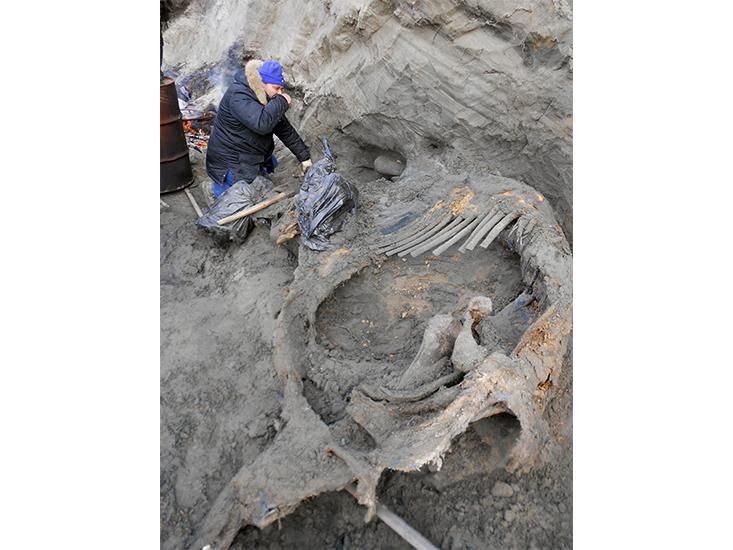Humans Were in the Arctic 10,000 Years Earlier Than Thought
Distinctive cut marks on a Siberian mammoth represent the first known evidence of human hunters this far north
/https://tf-cmsv2-smithsonianmag-media.s3.amazonaws.com/filer/e2/f1/e2f1ea94-7402-4e67-8add-c45db04bfac8/42-34917763.jpg)
Even though it was his first time handling the wooly mammoth’s bones, Vladimir Pitulko could envision the sequence of events that led to the animal’s demise on a desolate Siberian plain as clearly as if had witnessed it himself.
The grizzled mammoth lumbered into the clearing, its eyesight so poor it barely saw the small band of hunters leap from their hiding place and begin their coordinated assault. The humans hurled stone-tipped javelins at the mammoth to slow it down, and felled it by stabbing its sides with heavy spears. They focused their attacks on the beast’s left side, where it had suffered a previous head injury and was missing a tusk.
Amidst the carnage, one hunter saw an opening. He raised his weapon high and slammed it down, aiming for a spot at the base of the trunk. The hunter’s killing blow missed, and the errant spear tip gouged a deep hole in the mammoth’s cheekbone instead. But the animal was already mortally injured, and other blows quickly followed. The outcome was inevitable.
Plenty of previous evidence shows that humans hunted wooly mammoths during the late Pleistocene, with some studies arguing that our species hastened the mammoths' extinction. But the Siberian discovery is a surprise because it shows a mammoth hunt high in the Arctic around 45,000 years ago—ten millennia before humans were thought to have existed in this far north.
For anthropologists like Pitulko, the discovery site is tantalizing close to Beringia, an icy land bridge that once rose from the sea to connect Asia and the Americas. It's thought that humans crossed this bridge into North America sometime between 25,000 and 13,000 years ago, around the end of the last glacial maximum.
“The distance from the mammoth site to the Bering Strait is about 4,000 kilometers [2,500 miles]. It’s a long way to go, but they would have had thousands of years to make the journey,” says Pitulko, of the Institute for the History of Material Culture (IHMC) at the Russian Academy of Sciences. There is no archaeological evidence that humans crossed the land bridge 45,000 years ago, he cautions. "But at least now we know that humans were in the area.”
The partial mammoth carcass was discovered in 2012 in a coastal bluff on the eastern shore of Yenisei Bay, in the central Siberian Arctic. Radiocarbon dating of the animal’s tibia bone and surrounding materials indicate the mammoth died 45,000 years ago.
Although the site has not yielded any human-made tools, the mammoth's bones showed signs of trauma that were immediately recognizable as being made by human weapons, Pitulko and his colleagues argue in a new study appearing this week in Science. Stone spears likely made dents seen in the rib bones, while damage to the right tusk suggested the human hunters attempted to chop part of it off. The deep cut on the animal's cheekbone is reminiscent of injuries seen on modern elephants when human hunters try to sever major arteries near the base of the trunk.

If the findings are verified, it could mean the ancestors of modern humans left Africa earlier than previously thought, says Leonid Vishnyatsky, a Paleolithic archeologist at IHMC who was not involved in the study.
“To penetrate beyond 70 degrees North as early as this evidence is suggesting, our tropics-born ancestors, assuming these Arctic pioneers belonged to our own species Homo sapiens, had to probably start their out-of Africa-and-into-Eurasia odyssey much earlier than 50 or 60 thousand years ago,” Vishnyatsky wrote in an email. “Before getting so far north, they would have had to learn to survive in many different types of environments, and that doesn’t happen overnight.”
Pitulko says there is no doubt in his mind that the hunters were modern humans.
“I fully reject the idea of Neanderthal involvement in the case,” he says. “Neanderthals were still alive 45,000 years ago, but there is no indication at all that they ventured beyond 48 degrees North elsewhere. Also, Neanderthals are known to be based in mountain landscapes, more or less high, while we are speaking of open landscapes.”
The new findings could also be interpreted as support for the hypothesis that human settlement of the New World involved a millennia-long layover in Beringia that lasted up to 20,000 years, says Ripan Malhi, an anthropologist at the University of Illinois Urbana-Champaign.
“Early adaptations and technologies that allowed humans to live in the Arctic supports the idea of ancestors of current-day Native Americans living in Beringia for an extended period before peopling the Americas,” says Malhi.
John Hoffecker, a paleoanthropologist at the University of Colorado Boulder, has a more cautious take on the findings. “I don't think the new finds necessarily support the 'Beringia standstill' hypothesis,” says Hoffecker. “But they do fill in some background by confirming that humans were in the Arctic 45,000 years ago, and [possibly] in Beringia itself at this time.”
For IHMC’s Vishnyatsky, the intriguing question now is what could have driven early humans to such a remote region. “It seems unlikely that such factors as land shortage and demographic pressure were at work in North Eurasia at that time,” he says.
The answer might simply be that the Arctic was not as harsh as it is now, so humans readily used their advances in mammoth hunting techniques to follow their prey farther north. Evidence from Greenland ice core records, for instance, suggests that the Northern Hemisphere was undergoing a very warm period 45,000 years ago, Hoffecker says.
“Now we have confirmation that humans were present above the Arctic Circle at this time, and even perhaps in Beringia, which all makes sense,” he says.